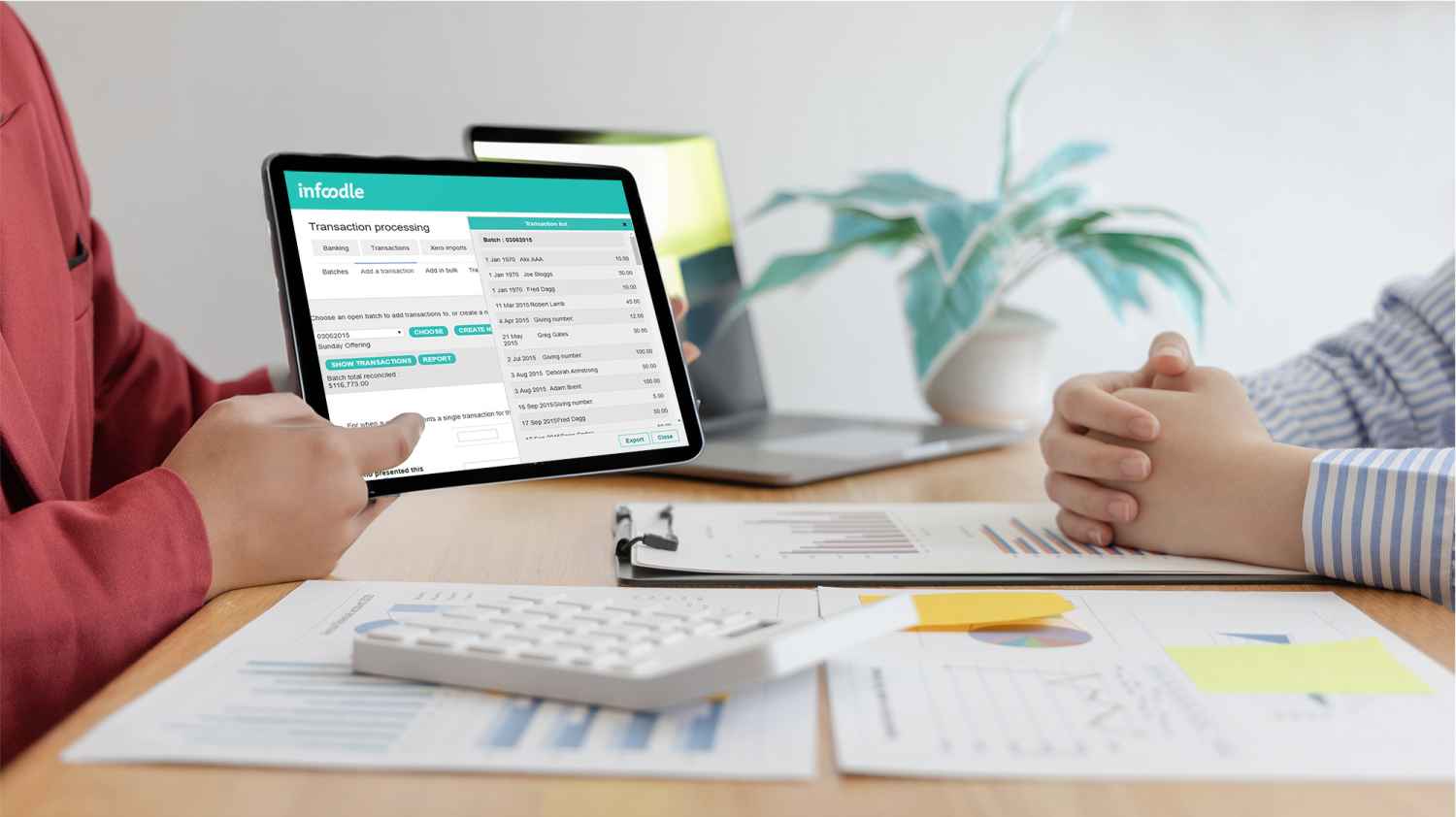Are you spending a lot of time maintaining multiple platforms that don’t talk to each other? Are you still manually importing financial data? It’s time to streamline your administration with a system that reduces time spent in admin and reduces errors.
Xero is a great accounting package, but it was designed to integrate with other add on apps, infoodle is just one of them. If you are a charity, not-for-profit organisation or church and use Xero, you may have noticed there are a few gaps in what Xero can do for you. It makes perfect sense to use infoodle finance particularly if you are already using infoodle CRM. If you are not yet using infoodle, there are even more reasons why you should use both infoodle packages and Xero together.
1. Contacts.
If Xero is the first place a contact is added or where people connect with your organisation, e.g. through a donation, then Xero can be the first time your organisation knows about this person. Therefore this is a good way of getting the data into the CRM because infoodle will automatically pull it in, and optionally update the contact data already in infoodle. Likewise, if you see a contact first in infoodle and they are likely to end up in Xero then infoodle can add to Xero also. Lastly any changes in infoodle for names and address details can be sent to Xero automatically e.g. an email address is updated – you only need to do it once.
2. Extending CRM data with Finance data.
Donors are the lifeblood of not-for-profit organisations, therefore effective donor management is vital so you can achieve your goals.
This is where the contacts that reside in infoodle can have additional data coming from Xero, primarily this is the donations/transactions that are being prepared and processed in Xero. With this extended data, there are a number of actions that can take place.
a) View donations
This can be handy as a way of separating who can see what financial information. Xero will contain information on payroll, suppliers, taxes etc as well as donors. Through infoodle you can give access to view just the donors and donations. Therefore making segmentation much easier if different people need to see different levels of data. Xero has no way of doing this.
b) Identify missing donations
Visually infoodle shows the financials for a contact – in a similar way to Xero – on the contact page. There is also a donor analysis which can be used in infoodle to look for regular donors and see whether they have missed 1 or more of their regular donations.
c) Match pledge data
infoodle can capture a commitment to giving, or pledged giving. This provides a way of recording that someone is going to donate every month for example. This assists with forecasting because using the Pledge vs Actual report, the user can forecast into the future to see how the cash is likely to flow. Likewise, this gives a view on how well people are keeping up with their commitments and how that is going to affect the forecast. Xero is not able to provide forecasting.
d) Statements
There is often a requirement to keep donors informed of how you are recording their donations. infoodle has the Statements feature which provides the ability to send by email or print a statement of activity. At the same time you can report on the progress of a project, prompting further donations and allowing the donor to check their giving. Sending statements based on types of activity is not something Xero can do.
e) Gift Aid
The infoodle Gift Aid feature for UK clients is a very popular feature. It uses the data that is brought in from Xero to match to a contacts approval of gift aid, and rapidly generates a gift aid filing that can be sent electronically. Just keeping track of people’s approvals can be administratively heavy. infoodle also enables you to capture any historic transactions if the approval to claim gift aid is received at a later date with no adjustments necessary. Xero has no Gift Aid features.
f) Tax Receipts
For non-UK clients the process and administration around issuing tax receipts can be cumbersome. There are challenges to list and separate taxable and none taxable activities, issuing one off receipts, or combining transactions over the year into a single receipt, splitting donations between couples for tax purposes – and ensuring the self management of getting receipts. All of this is a burden and infoodle makes light work of it.
g) Targeting communications
With the financials included with the CRM data, infoodle can now generate reports to target specific people for specific purposes. e.g. Who is in our newsletter list who has not donated to our Building fund in the past 6 months; or who has donated to the General fund, but not the Building fund; or who has given to the building fund in the past 12 months. There are much more complex combinations that can be created, but this gives a flavour of what you can do. With these types of filters, it’s possible therefore to send the right communications to the right people depending on your marketing strategy.
h) Generating invoices
If your community is using forms to sign up for activities you offer e.g. Events, Memberships, Donations as a business; then infoodle can use this data to create an invoice in Xero. This saves double handling.
i) Managing credit card batch payments
For Stripe, Go Cardless and Ezidebit – the bank will pay the funds into your bank account as a single payment, usually net of fees. This is a complex arrangement when you are required to claim gift aid or issue a receipt to the donor because they need to be done using the gross amount. If you have multiple payments in one payout it requires careful calculation of fees and net amounts to be split according to account codes and the original request and worked through Xero in order to calculate it. Infoodle has the information and calculates these correctly both for infoodle to allocate the gross amount to the donor, but also the gross + fees amounts for Xero to reconcile the transaction.
j) Splitting transactions for eftpos terminals
This is related to points i) and also point a). There are organisations who have a payment terminal on premises, receiving payments and donations, or donation boxes and offerings. Payments will be presented as a single amount to the bank which needs separating out. infoodle allows for manual entry or importing from CSV for a batch of transactions, tracking the date/donor/account code information (and more). This batch then can be pushed to Xero ready to reconcile the bank transaction. This helps tag the transaction to the donor, but also means a ‘collector’ can enter the data without the need to give access to Xero thereby delegating another task away from the bookkeeper.
So in summary – infoodles finance package gives access to more data to more people (permission based), and allows more people to assist in the administration (permission based). It gives greater accuracy with less manual handling of data and greatly speeds up the work the bookkeeper needs to do in the areas of gift aid, tax receipting and reconciliation. There is no need for double handling data or mail merges when sending receipts and statements.
Adding the infoodle finance packages works beautifully together with Xero
Contact infoodle today for more information or start a free trial. https://infoodle.com









